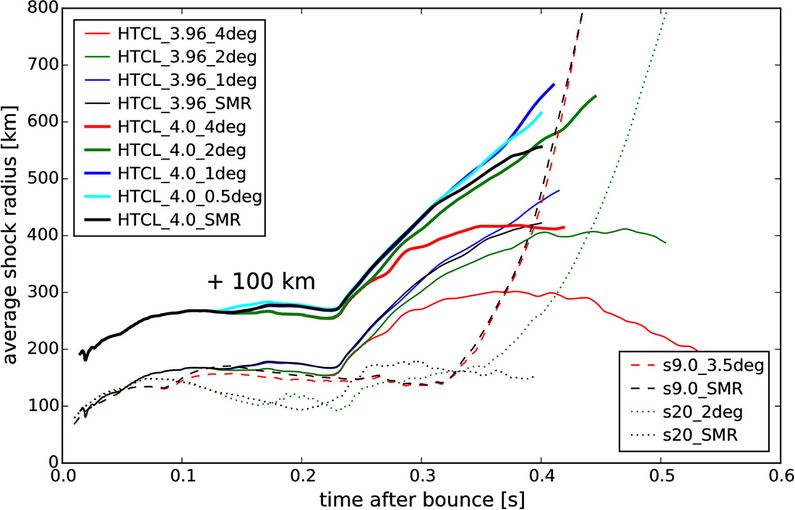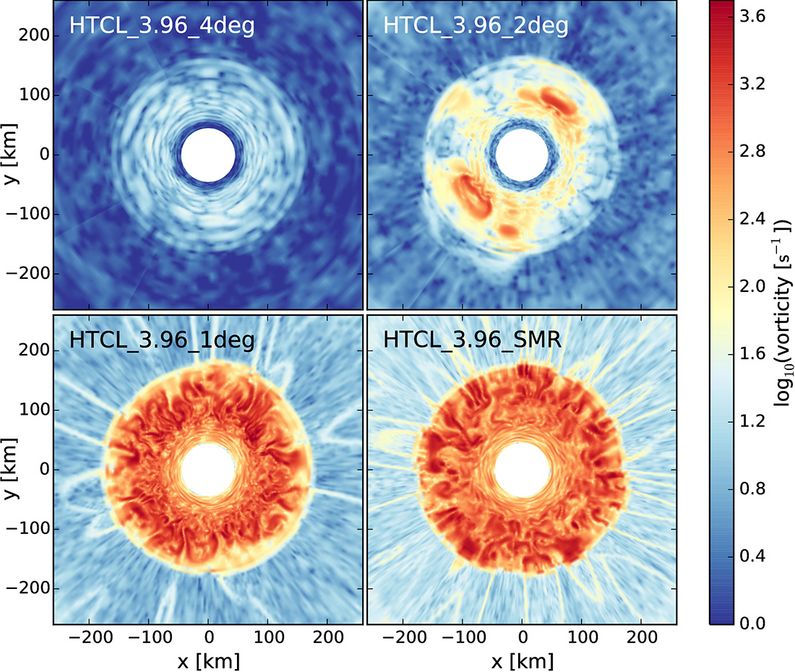ASTROPHYSICS
Towards Resolving the Turbulent Cascade in Self-Consistent 3D Core-Collapse Supernova Simulations
Principal Investigator:
Hans-Thomas Janka
Affiliation:
Max Planck Institute for Astrophysics, Garching (Germany)
Local Project ID:
pr48ra
HPC Platform used:
SuperMUC of LRZ
Date published:
First self-consistent, first-principle simulations in three dimensions have provided support for the viability of the neutrino-driven mechanism as an explanation of supernova explosions of stars with more than 8−10 solar masses. While these results respresent fundamentally important progress in our understanding of how massive stars terminate their lives, the enormous complexity and computational demand of the involved neutrino physics set severe resolution limitations to current full-scale supernova models. In this project, the numerical convergence of the present simulations were investigated.
Supernovae are among the most powerful explosions in the universe, play an important role as sources of neutrinos and gravitational waves, and act as crucial agents in the cosmic cycle of matter by disseminating the nuclear burning products of massive stars and by contributing new radioactive species assembled during the explosion. While the stellar core collapses either to a neutron star or a black hole, the surrounding material can be expelled in a supernova outburst. The possibility of such mass ejection is determined in a dynamical interplay of energy transfer (“heating”) by neutrinos from the new-born neutron star to the explosion shock, and violent hydrodynamic instabilities including turbulent flows, which provide decisive support for the onset of the supernova blast.
Detailed 3D simulations are therefore necessary to decide whether or not a star explodes. The first full-scale stellar core-collapse simulations in three dimensions, which have become feasible due to supercomputing power provided on SuperMUC by GCS and PRACE (Partnership for Advanced Computing in Europe) resources, indeed lend support to the neutrino-driven mechanism as the cause of successful supernovae. However, such simulations are extremely CPU-time consuming because of the enormous complexity of the neutrino physics and the grand challenges associated with a wide range of spatial and temporal scales that have to be bridged by the numerical models. Therefore the computational resolution of the existing successful models was still severely limited, and systematic investigations of the numerical convergence of the corresponding results, in particular with respect to the turbulent flows behind the supernova shock, are demanded.
Owing to the computer time granted for GCS Large-Scale project pr48ra a resolution study with this goal could be performed for the Prometheus-Vertex supernova code employed by the Garching group. Moreover, the project resources allowed for a test of a newly developed static mesh refinement (SMR) technique that is supposed to permit better numerical resolution in the turbulent postshock layer of full-scale supernova simulations without paying additional costs on the side of the extremely expensive neutrino transport.
Two full-scale supernova simulations including neutrino transport were performed for progenitor stars of 9.0 and 20.0 solar masses, using the SMR mesh with two refinement levels (for both angular directions of the employed polar grid) that allowed for an improved resolution of one degree in the neutrino-heating layer and 0.5 degrees in the turbulent postshock region instead of the standard uniform resolution of two degrees. These two runs amounted to roughly 50 million core hours each on the LRZ HPC system SuperMUC. Additional systematic resolution variations could be carried out with a simplified description of neutrino heating and cooling. They encompassed models with uniform cell sizes between four degrees (half the standard resolution) and 0.5 degrees (four times the standard resolution) as well as comparative runs with the described SMR grid, requiring another contingent of more than 50 million additional core hours.
The results of this study are summarized in Figs.1 and 2. They lead to the following important conclusions on the possibility to reliably capture the impact of turbulent convection on the onset of neutrino-driven explosions in simulations with the Prometheus-Vertex supernova code:
1. Calculations with higher angular resolution show more favourable conditions for explosions (Fig. 1). This backs up previous model runs where successful supernovae were obtained with the standard numerical grid.
2. Cases evolving very close to the explosion threshold exhibit a particularly strong resolution sensitivity. In such a situation low resolution can prevent the runaway expansion of the supernova shock.
3. Models with two degrees resolution show a clearly delayed development of turbulent postshock convection (Fig.2) and are marginally acceptable. Convergence seems to be achieved for an angular resolution around one degree.
4. The newly developed SMR technique can be safely applied for low-mass progenitors that are well beyond the critical threshold for explosion. However, the SMR grid has a damping effect on the explosion in cases near the borderline and therefore requires further improvements.
The described resolution study performed with a Gauss computer-time grant is an indispensable step to consolidate the still resolution-limited supernova simulations that are feasible on present-day supercomputers. The insights obtained in this project are of pivotal relevance for the strategic planning and optimization of future simulations, in particular with the SMR method, of this fundamentally important problem of stellar, nuclear, neutrino and gravitational astrophysics.

Figure 1: Time evolution of the angle-averaged shock radius for all simulations of the reported resolution study. Models s9.0 and s20 (dotted and dashed lines) are full-scale supernova simulations with sophisticated neutrino transport for 9 and 20 solar-mass stars performed with 3.5 degrees and two degrees angular resolution and a newly developed static-mesh-refinement (SMR) technique, respectively. The thin lines represent results for simulations with a simplified treatment of neutrino heating and cooling (HTCL) for a setup close to the explosion threshold; the thick lines (shifted by 100 km for better visibility) display results for a case with stronger tendency to explode. The different colours correspond to angular grids with different resolutions as indicated by the model names.
Copyright: MPA Garching
Figure 2: Vorticity in cross-sectional planes of four 3D simulations with different angular resolutions at 230 milliseconds after core bounce, i.e., after the stellar core has collapsed to a neutron star. The supernova shock can be recognized by the sharp discontinuity at a radius between 100 km and 200 km. It is clearly visible that low angular resolution (upper cases for four degrees, left, and two degrees, right) damps the development of turbulent postshock convection due to numerical viscosity, and that the model with static mesh refinement (SMR, bottom right) exhibits close similarity to the case with one degree angular resolution (bottom left).
Copyright: MPA GarchingResearch Team:
Tobias Melson, Alexander Summa, Hans-Thomas Janka (PI); Max-Planck-Institut für Astrophysik, Garching.
Andreas Marek; Max Planck Computing and Data Facility (MPCDF), Garching.
Publications:
[1] Melson, Tobias, Janka, Hans-Thomas, and Marek, Andreas.
Neutrino-driven Supernova of a Low-mass Iron-core Progenitor Boosted by Three-dimensional Turbulent Convection. Astrophysical Journal Letters 801, L24 (2015), arXiv:1501.01961
[2] Melson, Tobias, Janka, Hans-Thomas, Bollig, Robert, Hanke, Florian, Marek, Andreas, and Müller, Bernhard.
Neutrino-driven Explosion of a 20 Solar-mass Star in Three Dimensions Enabled by Strange-quark Contributions to Neutrino-Nucleon Scattering. Astrophysical Journal Letters 808, L42 (2015), arXiv:1504.07631
[3] Melson, Tobias.
Modeling Neutrino-driven Core-collapse Supernova Explosions in Three Dimensions. PhD Thesis. Technische Universität München (2016)
Scientific Contact:
Prof. Dr. Hans-Thomas Janka
Max Planck Institute for Astrophysics
Karl-Schwarzschild-Str. 1, D-85748 Garching (Germany)
e-mail: thj[at]mpa-garching.mpg.de